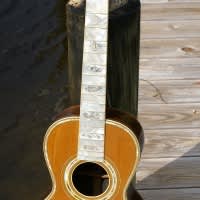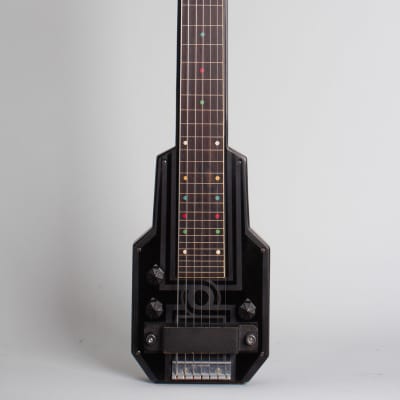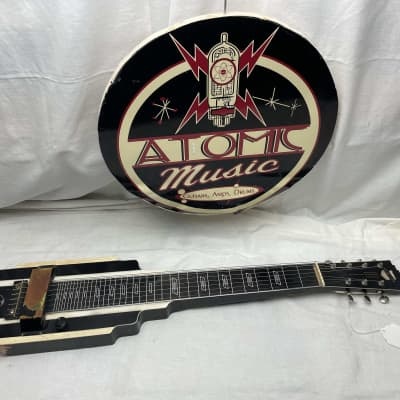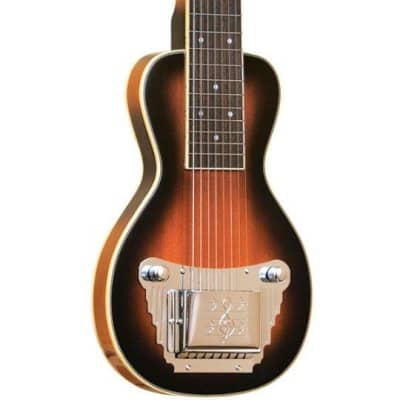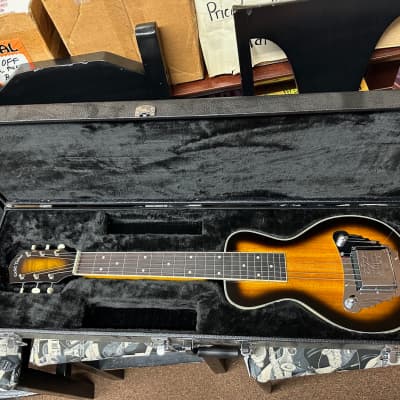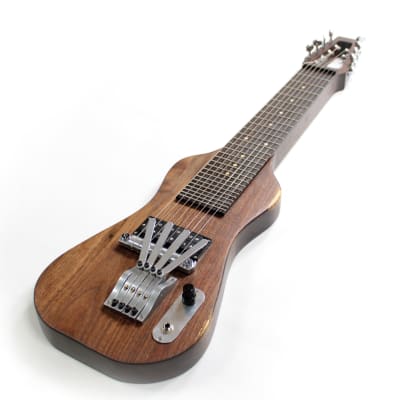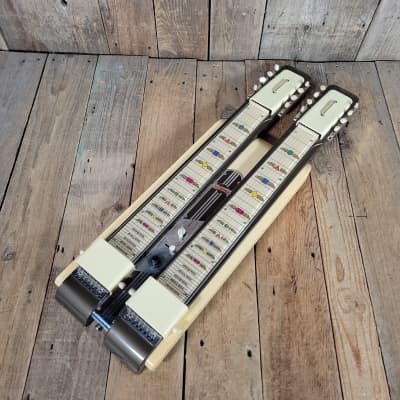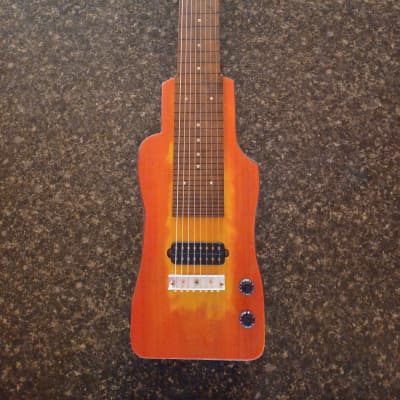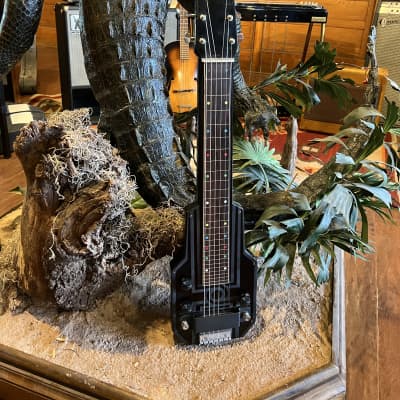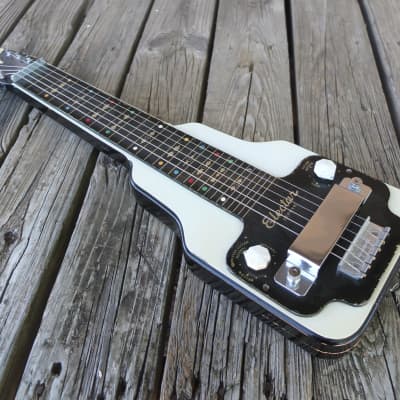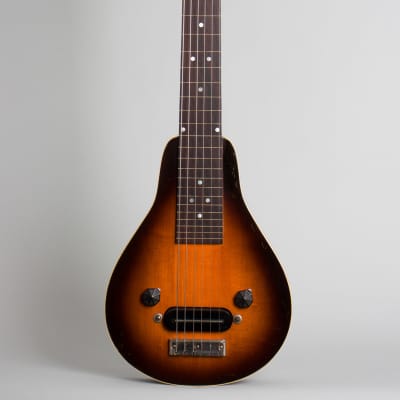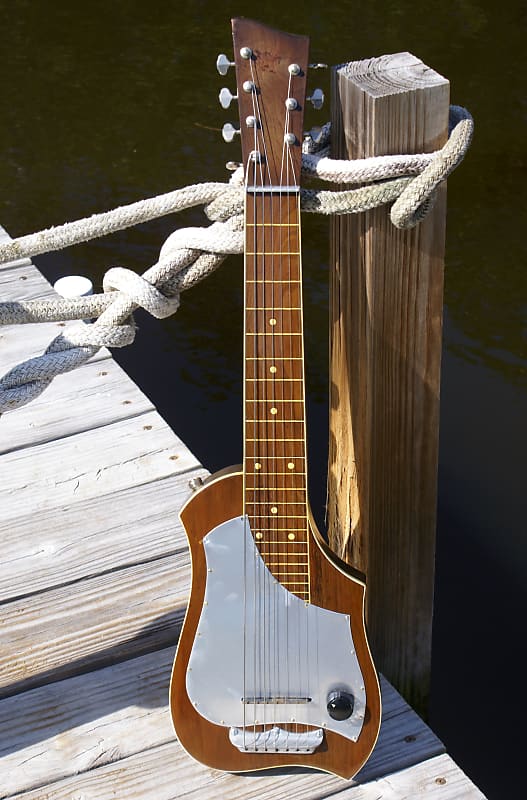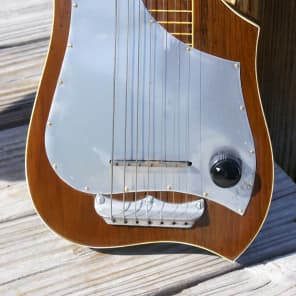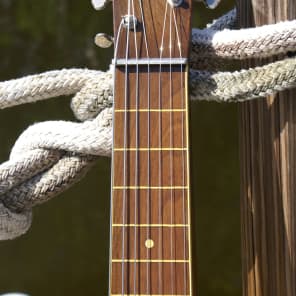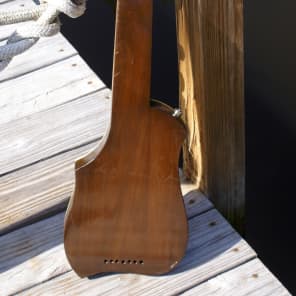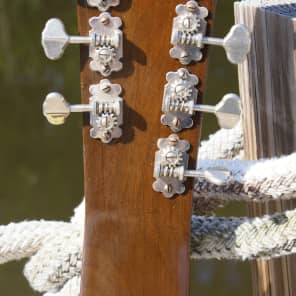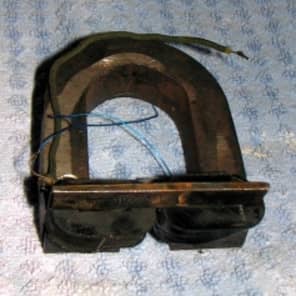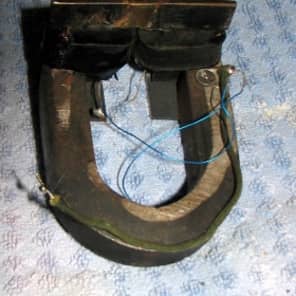Who developed the 1st electric guitar pickups?
Audiovox 7-String Model Lap Steel Electric Guitar – Circa mid '30s
Made in Seattle, WA.
Black
Walnut body and neck. Large horseshoe magnet twin coil pickup. Likely the first humbucker, decades ahead of Seth Lover's better known PAF's that Gibson introduced in 1955.
Apparently a lesser known story in the history of electric guitars,
the Audiovox brand has emerged from obscurity as the legacy of one of the earliest
pioneers of musical amplification, Paul Tutmarc. While not as well-known as the
contemporary early Rickenbacher Electro, Vivi-Tone or National/Dobro electrics,
Tutmarc’s pickup design was likely the first. Indeed, it was used in the first
patent granted for pickups. (See history below for details.) AudioVox
instruments were in production at the same time and in some ways were more futuristic.
Evidence shows that Tutmarc was the first to create a guitar-style electric
bass, many years before the previously accredited Leo Fender. This early
Audiovox steel was designed by Tutmarc in the mid-1930's and is a wonderful
piece of electric guitar history. Tutmarc was a Seattle player and teacher of
the Hawaiian guitar who was interested in the concept of amplifying his instrument
around 1930. Partnering with Art Stimpson, they designed a working magnetic
guitar pickup. With the help of local radio expert Bob Wisner, an accompanying
amplifier was also created. Tutmarc soon began hand-building solidbody steel
guitars using his pickup, but Stimpson favored selling the idea to an
established company. Without consulting his partner Stimpson took the design to
Dobro in Los Angeles, where it was patented as part of a proprietary guitar and
became the basis for the first National and Dobro electric instruments. Tutmarc
was likely displeased by this development, but continued to refine and market
his own electric instruments, albeit only on a small local scale. This is an
early production Audiovox 7-string Steel guitar, built with an advanced-looking
sculptured body that superseded the octagonal shape of the earliest models. The
earliest electric bass used this same body style. According to Tutmarc's son
Bud, the woodworking and finishing on these first production steels was done by
another Seattle resident, Emerald Baumsgard. Tutmarc himself fitted the
electronics.
The body has a celluloid bound neck and edges with dot fret
markers. The bridge and nut are metal, as is the coverplate on the face. There’s
a single volume pot on the treble side. This is a very fine sounding steel
guitar and an extremely rare and important instrument in the early development
of the electric guitar. Overall length is 31” (78.7 cm.), 8 11/16” (22.1 cm.) wide
at lower bout, and 1 5/8” (4.1 cm.) in depth, measured at side of rim. Scale length
is 22 ½” (572 mm.). String width at nut is 2” (56 mm.) and 2 5/8” (67 mm) at
the bridge. This one’s been thoroughly gone through, refinished &
refurbished. New screw-on Amphenol connector. Comes with a new gig bag.
History: In the winter of 1930-1931 Paul Tutmarc began
experimenting in his basement workshop with a fellow tinkerer on a secret
project. Tutmarc's collaborator was Arthur "Art" J. Stimson, a
jack-of-all-trades from Spokane, Washington, who'd worked as an auto mechanic
and an aerial photographer. Together the two -- each inspired by the
telephone's mechanism -- created a large mutant version of Ma Bell's dinky
transducer. They attached an iron blade with copper wire coiled around it to a
large horseshoe shaped magnet. When placed inside Tutmarc's flat-top
Spanish-style guitar and plugged into a converted radio, the magnetic device
picked-up the instrument's sound, amplified it, and surprised the partners with
the beautiful tone it brought forth.
The partners soon realized the importance of their
discovery, but they differed on the next step to take. Stimson wanted to sell
or license the "pickup" to some big company, while Tutmarc thought it
best to quietly seek protective registration for its design with the federal
Office of Patents. Unfortunately after investing $300 with attorneys who
initiated a patent search with the government, Tutmarc was ultimately advised
that their pickup design was non-patentable because the telephone companies had
already patented similar devices.
A disappointed Tutmarc put his electric guitar dreams on
hold, while Stimson, apparently, headed off to Los Angeles where he said he was
going to try to interest others in the idea.
One can imagine the shock then when Tutmarc -- a music
teacher, shopkeeper, and dealer of instruments -- eventually took notice after
a Los Angeles-based firm began selling their "Electro String
Instruments" in August 1932. That company (eventually known as
Rickenbacker International Corp.) was headed by a skilled engineer, Adolph
Rickenbacher, whose machine shop had been fabricating metal parts for two of
the town's successful guitar-making firms, the National String Instrument Corp.
and the related Dobro Manufacturing Co. since about 1928.
Then, in the spring of 1933, the Dobro firm began marketing
their All-Electric model of electrified Spanish-style guitar and Tutmarc must
have wondered how these companies could be pushing products without patent
protections. Little did he know that Dobro had actually filed (on April 7th,
1933) a patent application form -- not for the pickup alone, but in conjunction
with the overall guitar design. What Tutmarc learned, in time, was that Dobro's
patent application actually listed one "Art Stimson" as the assignor.
Worse yet: Tutmarc's erstwhile partner had apparently peddled their pickup
design to Dobro for the measly sum of $600.
The Audiovox Manufacturing Co.
Casting caution aside, Tutmarc finally forged ahead
marketing his own brand of electric guitars. Though a bit late to the race now,
Tutmarc became ever more determined to create a superior electric guitar and,
through more experimentation, vastly improved his old design, effectively
creating the world's first slanted split-polepiece magnetic
"humbucking" pickup -- a design that Dobro, National, and other firms
soon began emulating.
In 1934 Tutmarc relocated his shop to the Western
Laboratories Building (806 Pine Street) -- conveniently located above the
Birkel Electrical Supply Co., and just down the block from the grand Paramount
Theater -- and soon formalized his guitar building enterprise as the Audiovox
Manufacturing Company. Over time the Audiovox line of electric lap steel
guitars earned a reputation amongst players for having powerful-yet-clean
pickup sounds and Tutmarc established friendships with some of the era's top
steel guitarists including: Sol "The King of the Hawaiian Guitar"
Ho'opi'i, Dick Kaihue McIntire, and Frankie McPhalen.
Tutmarc himself was Audiovox's best promoter, and in
addition to selling instruments to his students and working musicians, he
consigned them to a few other regional music shops, and captivated listeners
with daily "Free Concert Demonstrations" at his shop and at other
downtown stores including the Sears, Roebuck & Co. department store and
Myers Music store, and on his weekly KOMO radio show.
- In
February 1935, the Seattle Post-Intelligencer discovered
Tutmarc and ran a photograph showing him with his latest invention -- an
electrified, cello-sized, solid-bodied bass instrument -- and noted that
"People have always pitied the poor bass-fiddler ... who has to lug
his big bull-fiddle home through the dark streets after the theatre
closes. But he doesn't have to do it any more. Because Paul Tutmarc,
Seattle music teacher and KOMO radio artist, has invented an electric bull-fiddle.
One you can carry under your arm ... . The first electric bass-viol is
only four feet tall, instead of six. It could be made a lot smaller, but
Tutmarc didn't want to be too revolutionary right off the bat. Bass
violinists are a conservative race, and have to be accustomed gradually to
the idea, he says." - HistoryLink.org Essay 7479
About me: I try
to acquire, play, and sell only the finest most sought after instruments.
Although at times I don’t know what shape some gear is in before checking it
thoroughly, I aim for mint or near mint works. We highly recommended buying
instruments in this realm of quality, as the investment yield is always greater
when buying rare models in exemplary condition. I’ve been a collector for over
50 years. Over 1000 vintage guitars have passed through my hands.
*Please see our
other listings and store for many other Vintage (Lap Steel) Guitars and
Amplifiers. We currently have Alamos, Audio Vox, Bronsons, Dickersons, Dobros,
English, Epiphones, Fenders, Gibsons, Harlin Bros, Harmonys, Kays, Maestros,
Magnatones, McKinney, Nationals, Oahus, Rickenbachers, Sho Bud, Silvertones,
Supertones, Supros, Vegas, and White Lap Steels as well as several others.
We've been in the guitar business for over 50 years. We encourage you to
contact us with any questions or comments*
*We also accept
Cashier's Checks, Bank Transfers & other forms of payment. We ship
(worldwide) at cost. Please contact for information.*
